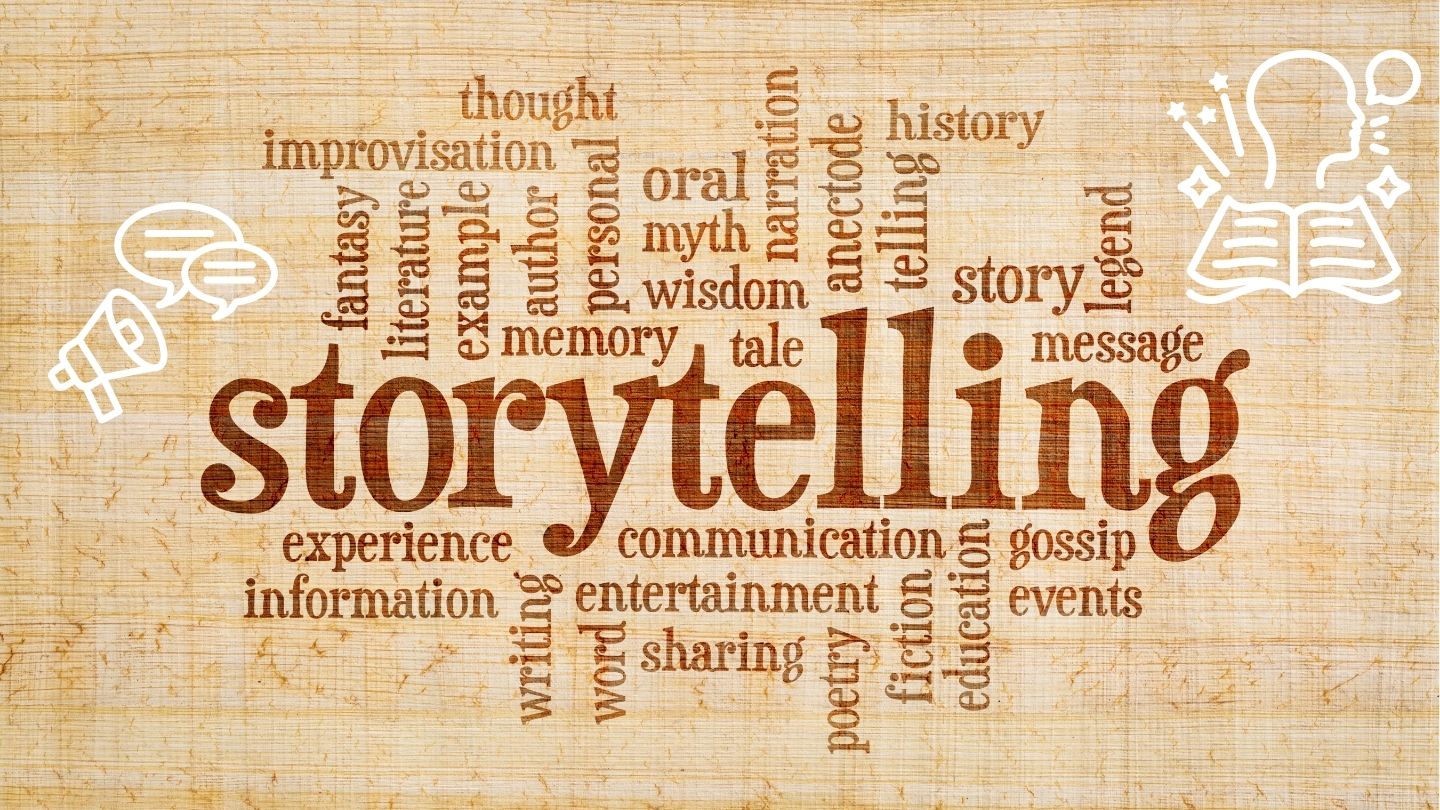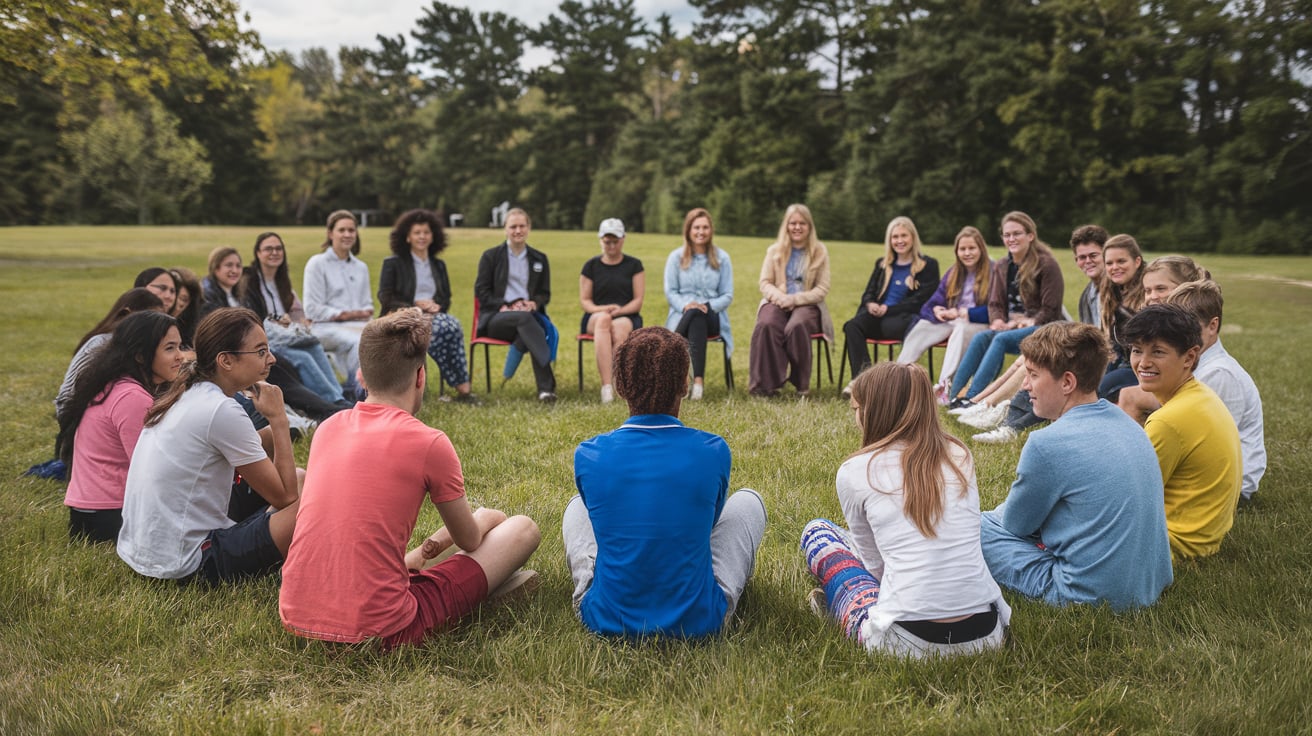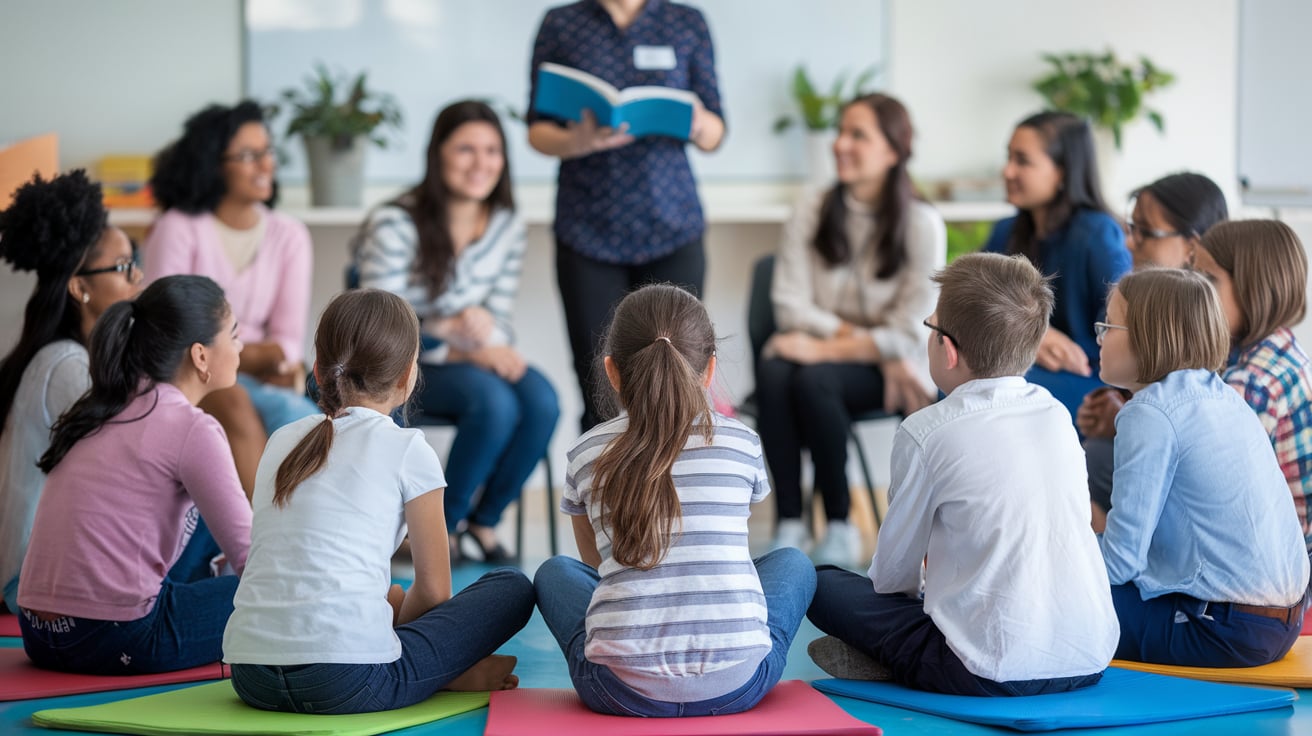
How Storytelling Enhances Learning Across Subjects
Why stories help lessons stick
Teachers and parents see it every day. A short story at the start of a lesson holds attention, connects new ideas to what learners already know, and makes recall easier a week later.
Research backs this up. Narrative materials often produce stronger comprehension and memory than plain expository text across large samples.
In science communication, story structure helps non-experts grasp complex ideas without watering them down.
When stories are paired with pictures, diagrams, or hands-on objects, memory gains rise further. Add quick recall checks during and after the story, and the effect compounds over time.
This article turns that evidence into step-by-step guidance you can use in science, mathematics, history, and language arts.
The goal is simple: clear, practical methods that improve learning while keeping facts front and center. Where claims call for a source, you will see a citation.
Table of Content
- How Storytelling Enhances Learning Across Subjects
- Why stories help lessons stick
- How storytelling works in the mind
- What the evidence shows across subjects
- Core principles for story-based teaching
- Planning a story-based lesson (step by step)
- Subject-specific playbooks
- Questioning skills: the engine inside the story
- Assessment that values both truth and clarity
- Equity, access, and inclusion
- Digital storytelling without distraction
- Field notes from practice
- Common pitfalls and how to avoid them
- A one-week starter plan
- Why this approach stays relevant over time
- Conclusion
- FAQs
How storytelling works in the mind
Narrative as a sense-making tool
Psychologist Jerome Bruner described a “narrative mode” of thought: people make meaning by linking events, goals, actions, and outcomes. In class, that structure turns scattered facts into a coherent mental model. Learners can then retell, compare cases, and apply the same pattern in new settings.
Dual coding: words and images together
When a teacher pairs a short story with a diagram, a timeline, a sketch on the board, or a simple prop, learners encode the idea through verbal and nonverbal channels. Two paths into memory support recall and transfer. This is the core of dual coding theory, which has been applied to classroom practice for decades. Keep visuals clear and purposeful, and avoid decorative clutter.
Motivation and relevance
Learning improves when tasks feel meaningful and connected to prior experience. A good story does that work quickly: it supplies context, purpose, and a reason to care about the next question or problem.
The National Academies’ How People Learn II highlights motivation as a key driver of attention, persistence, and achievement across settings.
Retrieval practice pairs well with stories
Memory grows when learners recall information from memory, not only when they re-read it. Short “pause-and-recall” moments inside a story—followed by a quick exit ticket—produce large gains on delayed tests in lab and classroom studies. Stories help here too, since plot points and characters become easy cues for recall.
What the evidence shows across subjects
Broad pattern: narrative vs expository
A recent meta-analysis pooling more than 33,000 participants found that stories, on average, yield better comprehension and memory than expository texts. The mean effect size sat around half a standard deviation. The advantage held across many study designs.
Science classrooms
Synthesis work in science education reports a small but reliable edge for narrative materials over expository text. The benefit rises when the story centers real investigations or the lives of scientists, then asks learners to reason with evidence.
Narrative-centered learning environments
In studies of CRYSTAL ISLAND (a narrative microbiology environment for middle school), higher engagement tracked with higher learning gains, independent of prior knowledge or gaming experience. That pattern challenges the fear that stories distract from content.
Early mathematics
Field studies and randomized trials from the PBS Ready To Learn initiative show that story-based, transmedia resources (episodes, games, guided activities) improve early math skills for young children, including those from underserved communities.
Language and literacy
Systematic reviews of digital storytelling and story-focused instruction report gains in motivation and in language outcomes such as narrative production and comprehension. Clear structure prompts—setting, problem, attempts, outcome—play a key role.
Core principles for story-based teaching
Keep the plot tight and truthful
Pick a short scenario that points straight at the day’s learning target. Every beat in the story should carry content: observation, question, test, result, or claim. If a detail fails that test, cut it.
Science communication research warns that unchecked stories can spread misconceptions. Use source checks and refutation prompts when needed.
Link each plot point to a visual
Story plus diagram beats story alone. A number line, causal loop, graph, timeline, or labeled sketch turns words into concrete steps the mind can revisit later. Dual coding research supports this pairing across ages.
Build in recall moments
Insert two or three quick recall prompts during the lesson. Ask students to retell the last step in one sentence, sketch the process from memory, or answer a single question without notes. Retrieval practice strengthens long-term memory and supports transfer.
Use spacing
Revisit the same storyline across days. A returning character or setting becomes a durable cue for prior knowledge, which makes new content easier to attach. Spaced retrieval improves retention in both lab and classroom work.
Planning a story-based lesson (step by step)

Step 1 — Define the target and the likely misconception
Write the exact concept or skill in one line. Add the misconception you expect to meet. For example, “current is used up” in a circuit lesson, or “seasons come from distance to the Sun” in Earth science.
Frame the story so the misconception gets tested, not ignored. Guidance from How People Learn II stresses the role of prior knowledge in shaping new learning.
Step 2 — Pick a short, relatable frame
One class period needs one clear conflict. A lab intern faces puzzling test results. A shop owner must set fair prices. A field reporter needs to verify claims about a public claim or graph. Brevity helps.
Step 3 — Map the visuals
Decide which diagram or object sits with each beat. Use plain lines, clear labels, and only the marks you will refer to aloud. Avoid extra decoration.
Step 4 — Decide where learners will predict
Good prediction points: before a test, at a model twist, or when two explanations compete. Ask for a sentence, a quick vote, or a hand-drawn arrow on a mini-whiteboard.
Step 5 — Add micro-retrieval
Plan a 45-second no-notes recall. Examples: a one-line retell, three key terms in context, or a fast sketch from memory. Repeat near the end.
Step 6 — Close with transfer
Use a fresh case so students apply the same idea in a new setting. Ask them to narrate a new “episode” that shows the concept at work.
Subject-specific playbooks
Science
Concept stories
Use a simple, accurate narrative to explain a process: a carbon atom’s path through photosynthesis and respiration; a water molecule moving through states; a gene switched on and off. Keep mechanism language precise. Pair story beats with diagrams and verification questions. Science communication studies support this format for non-experts.
History-of-science vignettes
Short accounts of real investigations (Pasteur, Franklin, Faraday, McClintock) reveal hypothesis, method, evidence, and revision. Ask learners to map each step to today’s lab or simulation. Meta-analytic work in science education notes a performance edge when stories ground ideas in real inquiry.
Lab as a story
Have groups storyboard the lab: prediction, setup, test, observation, explanation. At the end, each team records a 60-second oral retell for a younger student. Tie grading to accuracy and clarity.
Mathematics
Micro-stories for problem contexts
“Market Day” is a reliable frame: pricing, inventory, discounts, and fair bundles. Use ratio tables and graphs as the visual layer for the same story. Ready To Learn studies show gains when math concepts live inside a coherent story world with guided activities.
Data-to-story routine
Variables become “actors” with constraints. Students narrate trade-offs (price vs demand) before writing equations. The story gives purpose to representation and makes reflection easier later.
Spiral the arc
Revisit the same store or team across a unit: fractions in week one, percentages in week two, linear models in week three. Spacing supports retention.
History and social studies
First-person sources
Use letters, diaries, or oral histories to build perspective. Then corroborate with maps, data, and images. Interactive, story-rich tasks tend to raise curiosity and historical empathy when tied to source work and guided discussion.
Case narratives with evidence checks
Present a civic dilemma in a short vignette. Ask learners to argue options, cite policy text, and predict outcomes. Keep the narrative balanced and grounded in primary sources.
Language and literacy
Story grammar frames
Teach structure explicitly: setting → problem → attempts → outcome → lesson. Have learners retell aloud before writing. Reviews indicate positive effects on narrative production and comprehension, including in second-language contexts.
Digital storytelling
Short, purposeful digital stories can lift motivation and support reading, speaking, and vocabulary growth. Keep tasks brief, collaborative, and data-light; focus on clarity of message over flashy effects.
Questioning skills: the engine inside the story
Stories set the scene. Questions drive thinking. Map your prompts to each beat:
-
Notice: What do we see or know so far?
-
Predict: What should happen next?
-
Explain: What would count as evidence?
-
Probe cause: What changed the outcome?
-
Test the rival idea: How could we check an alternative?
Linking story beats to targeted questions supports retrieval, metacognition, and transfer. Research on retrieval practice provides the memory backbone for this routine.
Assessment that values both truth and clarity
Two-lens rubric
-
Content lens: accuracy, use of terms in context, link between claim and evidence, correct representation (graph, table, or diagram).
-
Narrative lens: clear goal, coherent sequence, audience-ready explanation, source credit when needed.
Fast checks
-
One-sentence retell: “What changed and why?”
-
Narrate a diagram step by step.
-
Mini-podcast (60–90 seconds) explaining a new case with the same idea.
Evidence of learning
Look for correct causal language, correct quantities, and correct linking of steps in a process. Keep audio or text samples as artifacts for growth over time.
Equity, access, and inclusion
Representation matters
Rotate protagonists, settings, and examples so more learners see their communities and interests reflected. That simple move signals belonging without changing rigor.
Multiple access points
Offer oral narration, captions, transcripts, and bilingual glossaries. Allow alternate formats for student stories (comic strip, audio log, slide deck). The goal is clear expression of correct ideas.
Guardrails against bias
Stories can tilt toward single-group viewpoints. Use multiple sources, check claims, and invite counter-narratives with evidence. Science communication research cautions against persuasive stories that skip fact-checking.
Digital storytelling without distraction
Short beats work best. Pick familiar tools already in your school. Limit effects and transitions; invest time in a clean script and a clear diagram.
Reviews of digital storytelling highlight positive shifts in motivation and skill when tasks stay simple and focused on ideas.
Field notes from practice
-
Start small. Open next week’s lesson with a two-minute story tied to one standard. Add one diagram and two recall prompts.
-
Reuse story worlds. Return to the same setting in later lessons, so retrieval happens almost automatically.
-
Publish student episodes. A shared folder or class site lets learners see models, compare approaches, and reflect on growth.
-
Keep a claim-check habit. Before any public share, ask groups to list sources and mark any approximations.
Common pitfalls and how to avoid them
Seductive details
Colorful side notes that do not serve the concept increase extraneous load. Trim them. Keep the causal chain visible in both words and visuals. Evidence from narrative learning environments shows that engagement can support learning when tasks stay aligned with goals.
Overlong arcs
A 40-minute backstory drains time from practice. Favour micro-stories that move quickly to prediction, testing, and recall.
Unchecked claims
Any claim wrapped in a good story sounds convincing. Build in verification. Ask students to mark which parts are measured, which are inferred, and which need a source. Science communication papers highlight this risk and offer clear warnings.
A one-week starter plan
-
Day 1: Launch a micro-story tied to a single target. Sketch one diagram live.
-
Day 2: Add a hands-on step. Pause twice for recall.
-
Day 3: Learners draft a 150-word “next episode” applying the idea in a new case.
-
Day 4: Peer review with the two-lens rubric.
-
Day 5: Short no-notes quiz plus a fresh transfer task; end with a two-minute debrief on what made the story clear.
Why this approach stays relevant over time
Storytelling in education does not depend on a platform or a trend. The cognitive pieces—meaning making, dual coding, retrieval, spacing—are stable, well-studied, and adaptable to any subject or level.
The research base spans decades, from classic theory to recent large-scale syntheses and program evaluations.
Conclusion
Story-based teaching turns lessons into sequences learners can remember and reuse. A short, accurate scenario gives context. Clean visuals give form. Targeted questions prompt thinking.
Brief recall moments lock in gains. The same pattern works in science labs, word problems, primary sources, and writing workshops.
Start with one micro-story next week, keep the plot honest, and watch how often students refer back to it when solving new problems.
FAQs
1) Does storytelling reduce rigor in STEM subjects?
No. Studies with narrative science materials and narrative-centered environments show learning gains when tasks still demand correct reasoning with evidence. The story frames the work; it does not replace it.
2) How long should a class story be?
Two to three minutes at launch is plenty for most lessons. Move quickly to prediction or practice, then return to the story in brief check-ins. Short beats help memory and pacing. Evidence on dual coding and retrieval favours concise, high-signal input.
3) What formats work best for young learners?
Picture-rich micro-stories, simple songs, puppets, and short digital clips. Ready To Learn studies found gains with short episodes and guided play that target specific math ideas.
4) How do I keep stories accurate when teaching science or health?
Plan the causal chain first. Cite data or accepted models. Label approximations. Invite students to challenge claims and bring a source. Science communication research warns against persuasive stories that skip verification.
5) Where can I point families who ask for home activities?
Send home a one-page guide: tell a daily “how something works” story with a quick sketch and one question, then ask the child to retell it at dinner. This blends story, picture, and recall—the same trio used in class.
Learning Skills


